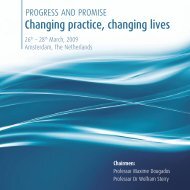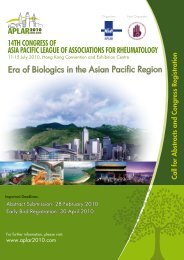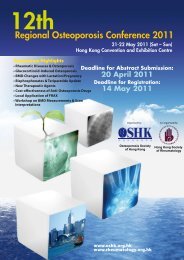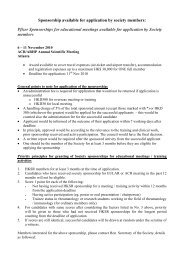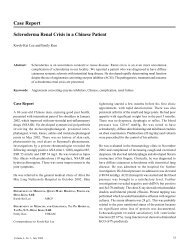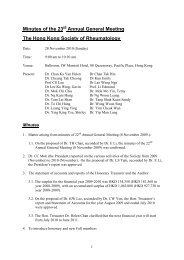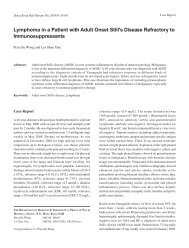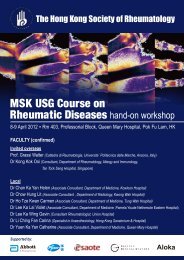Highlights on the APLAR Scientific Symposium 2011
Highlights on the APLAR Scientific Symposium 2011
Highlights on the APLAR Scientific Symposium 2011
Create successful ePaper yourself
Turn your PDF publications into a flip-book with our unique Google optimized e-Paper software.
H<strong>on</strong>g K<strong>on</strong>g Bull Rheum Dis <strong>2011</strong>;11:28-30<br />
<str<strong>on</strong>g>Highlights</str<strong>on</strong>g> <strong>on</strong> <strong>the</strong> <strong>APLAR</strong> <strong>Scientific</strong> <strong>Symposium</strong> <strong>2011</strong><br />
T<br />
he first symposium of <strong>the</strong> Asian Pacific League of Associati<strong>on</strong>s of Rheumatology (<strong>APLAR</strong>), <strong>the</strong>med "New Fr<strong>on</strong>tiers in<br />
Clinical Rheumatology", was held in Taipei this year.<br />
The meeting began with a half-day review course, during which various topics including psoriatic arthritis, rheumatoid arthritis,<br />
osteoporosis, systemic lupus ery<strong>the</strong>matosus, dermatomyositis/polymyositis and gout, were reviewed by different rheumatology<br />
specialists. It offered an excellent warm up and c<strong>on</strong>cise review for participants and trainees.<br />
Rheumatoid arthritis (RA) was <strong>on</strong>e of <strong>the</strong> main <strong>the</strong>mes of <strong>the</strong> symposium. Professor Joseph Smolen and Paul Emery discussed<br />
<strong>the</strong> different definiti<strong>on</strong>s of remissi<strong>on</strong> (clinical, structural and functi<strong>on</strong>al) and <strong>the</strong> different composite disease activity measures<br />
for RA. They also introduced <strong>the</strong> new ACR-EULAR <strong>2011</strong> remissi<strong>on</strong> criteria, and emphasized that remissi<strong>on</strong> should be <strong>the</strong><br />
appropriate treatment target in treating RA. In <strong>the</strong> c<strong>on</strong>current sessi<strong>on</strong>, Professor Ernest Choy provided a detailed review <strong>on</strong> <strong>the</strong><br />
cardiovascular (CV) risk in RA. In fact, CV mortality is increased in patients with RA. However, traditi<strong>on</strong>al cardiovascular risk<br />
factors including lipid could not account for <strong>the</strong> increased CV risk in RA patients. Interestingly, inflammati<strong>on</strong> and lipid level<br />
have an inverse relati<strong>on</strong>ship. Studies showed that cardiovascular risk could be reduced by c<strong>on</strong>trolling inflammati<strong>on</strong>, ei<strong>the</strong>r with<br />
disease modifying agents (such as methotrexate) or anti-tumor necrosis factor (TNF) <strong>the</strong>rapy.<br />
Ano<strong>the</strong>r hot topic, systemic lupus ery<strong>the</strong>matosus (SLE), was reviewed by Professor Michelle Petri, who is <strong>on</strong>e of <strong>the</strong> famous<br />
leading rheumatologists in <strong>the</strong> world. She discussed <strong>the</strong> systemic lupus internati<strong>on</strong>al collaborating clinic (SLICC) revisi<strong>on</strong> of<br />
<strong>the</strong> American College of Rheumatology (ACR) classificati<strong>on</strong> criteria for SLE and stressed <strong>the</strong> importance of use of<br />
hydroxycloroquine in management of SLE. She <strong>the</strong>n gave a c<strong>on</strong>cise summary <strong>on</strong> <strong>the</strong> management of lupus nephritis in <strong>the</strong><br />
c<strong>on</strong>current sessi<strong>on</strong>, which was fur<strong>the</strong>r supplemented by a detailed review of <strong>the</strong> latest clinical trials <strong>on</strong> <strong>the</strong> inducti<strong>on</strong> and<br />
maintenance <strong>the</strong>rapy for lupus nephritis by Dr CC Mok, our H<strong>on</strong>g K<strong>on</strong>g Rheumatology Society president.<br />
An updated review <strong>on</strong> sp<strong>on</strong>dyloarthritis was given by Professor Desiree van der Heijde. There are new Assessment of<br />
Sp<strong>on</strong>dyloArthritis internati<strong>on</strong>al Society (ASAS) classificati<strong>on</strong> criteria for axial and peripheral sp<strong>on</strong>dyloarthritis. It makes earlier<br />
diagnosis as well as earlier treatment and better l<strong>on</strong>g-term outcome possible. According to <strong>the</strong> ASAS/EULAR recommendati<strong>on</strong>s<br />
for <strong>the</strong> treatment of ankylosing sp<strong>on</strong>dylitis, NSAIDs are recommended as first line drug <strong>the</strong>rapy for patients with pain and<br />
stiffness. Sulphasalazine may be c<strong>on</strong>sidered in patients with peripheral arthritis. Anti-TNF <strong>the</strong>rapy should be given to patients<br />
with persistently high disease activity despite c<strong>on</strong>venti<strong>on</strong>al treatments according to <strong>the</strong> recommendati<strong>on</strong>s.<br />
For <strong>the</strong> osteoporosis c<strong>on</strong>current sessi<strong>on</strong>, c<strong>on</strong>cept of postmenopausal and glucocorticoid-induced osteoporosis and <strong>the</strong>ir<br />
management approach were discussed. In ano<strong>the</strong>r sessi<strong>on</strong> <strong>on</strong> gout, <strong>the</strong> experience <strong>on</strong> <strong>the</strong> use of febuxostat was provided and <strong>the</strong><br />
importance of <strong>the</strong> associati<strong>on</strong> of hyperuricemia and gout with cardiovascular diseases was emphasized.<br />
O<strong>the</strong>r sessi<strong>on</strong>s including <strong>the</strong> industry symposiums were just as informative. The first <strong>APLAR</strong> scientific symposium had successfully<br />
been launched this year and I am looking forward to <strong>the</strong> next symposium.<br />
Dr O'Young Kit Ying Cecilia
<str<strong>on</strong>g>Highlights</str<strong>on</strong>g> <strong>on</strong> <strong>the</strong> <strong>APLAR</strong> <strong>Scientific</strong> <strong>Symposium</strong> <strong>2011</strong><br />
29<br />
T<br />
his year, <strong>APLAR</strong> held its first symposium in Taiwan, which is a city mixing with both modern and traditi<strong>on</strong>al Chinese<br />
culture. More than twenty H<strong>on</strong>g K<strong>on</strong>g delegates attended <strong>the</strong> c<strong>on</strong>ference. It was a relatively short symposium lasting for<br />
3 days, yet it was very fruitful. Many internati<strong>on</strong>ally famous rheumatologists were invited to be <strong>the</strong> speakers of this symposium<br />
and t<strong>on</strong>s of new advances in rheumatology were presented.<br />
In <strong>the</strong> first plenary sessi<strong>on</strong>, Professor J Smolen, <strong>on</strong>ce again remained us <strong>the</strong> importance of treat to target (T2T) in <strong>the</strong> management<br />
of rheumatoid arthritis (RA). He suggested to us that a more stringent remissi<strong>on</strong> criteria should be employed, as <strong>on</strong>going joint<br />
destructi<strong>on</strong> were observed in patient who are declared to be in remissi<strong>on</strong> in <strong>the</strong> current EULAR remissi<strong>on</strong> criteria (DAS 28<br />
30 <str<strong>on</strong>g>Highlights</str<strong>on</strong>g> <strong>on</strong> <strong>the</strong> <strong>APLAR</strong> <strong>Scientific</strong> <strong>Symposium</strong> <strong>2011</strong><br />
The old nati<strong>on</strong>al university hospital of Taiwan<br />
Dr. N. Schlesinger's talk <strong>on</strong> <strong>the</strong> applicati<strong>on</strong> of USG in gouty arthritis<br />
H<strong>on</strong>g K<strong>on</strong>g Delegates<br />
David - a sufferer of gouty arthritis too?



